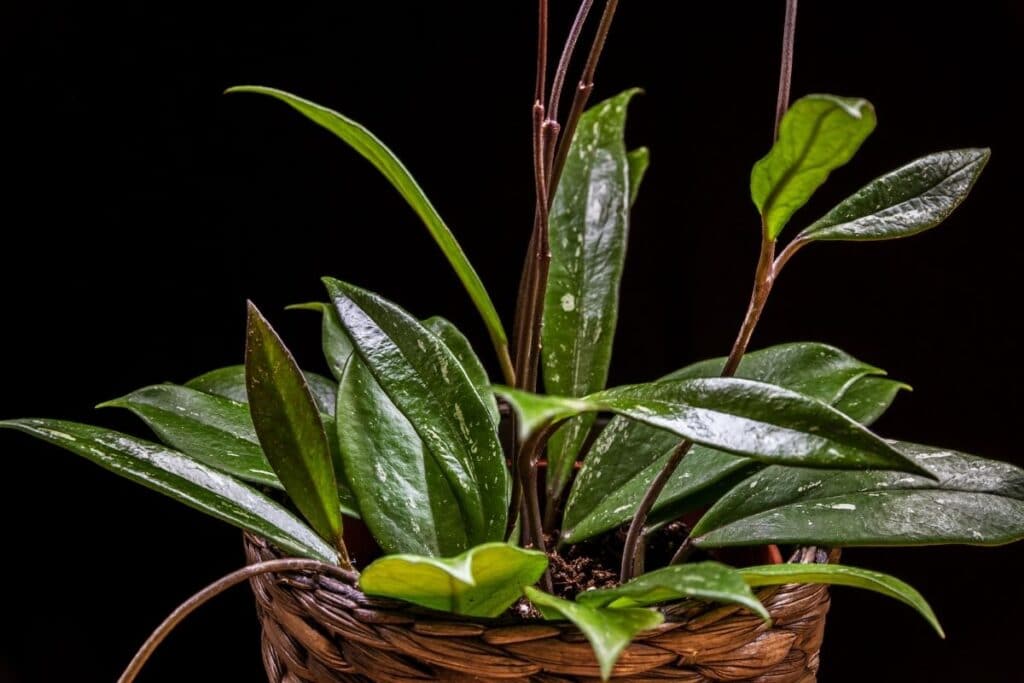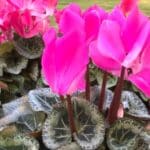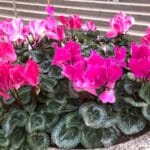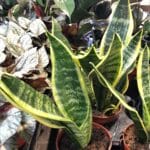If you’re looking for an easy-to-grow houseplant, look no further than the Hoya pubicalyx. This succulent is known for its trailing vines and abundance of star-shaped flowers.
Best of all, it requires very little care to keep it happy and healthy.
In this article, we’ll teach you everything you need to know about growing and caring for a Hoya pubicalyx.
Read on to learn more!
Plant Facts
| Scientific name | Hoya pubicalyx |
| Common names | Porcelain flower, silver pink vine, wax plant |
| Family | Apocynaceae |
| Plant Type | Houseplant |
| Height and Width | 10’ tall and 4” wide |
| Origin | Philippines |
| Flower colors | Pink |
| Foliage color | Green |
| Sun Exposure | Partial shade to full sun |
| Soil Type & pH | Well-drained soil |
| Special features | Low maintenance, good around pets, partial shade tolerance, epiphytic plant |
How to Grow Hoya Pubicalyx
H. pubicalyx, also known as the wax plant, is a beautiful and easy-to-care-for houseplant. Native to Southeast Asia and the Philippines, it is a climbing or trailing plant that can reach up to 10 feet in length. The leaves are dark green and glossy, and the flowers are pink. Hoya pubicalyx is a relatively slow grower, but with proper care, it can bloom multiple times a year.
Here are some tips for growing the wax plant indoors.
Propagation
If you’re looking for a fast and easy way to propagate H. pubicalyx, stem cuttings are the way to go.
First, choose a healthy stem that has at least 2-3 nodes (the small bumps where leaves are attached). Next, using a sharp knife or shears, cut the stem just below a node. Once you have your cutting, strip off any lower leaves so that only the upper leaves remain. Finally, place the cutting in a well-drained potting mix and water lightly.
Keep the soil moist but not soggy, and in 6-8 weeks your cutting should have rooted and be ready to transplant.
Another method of propagation is by leaf cuttings. Again, choose a healthy leaf and cut it off at the base, near the stem. Dip the cut end in rooting hormone and plant it in moistened potting mix. Place the pot in a warm, bright location and keep the soil moist but not soggy. New plants will emerge from the soil shortly.
Soil
When it comes to soil type, H. pubicalyx prefers well-drained, sandy loam soil that is high in organic matter. The soil should also be slightly acidic, with a pH level between 6.0 and 7.0. If you are unsure about the pH level of your soil, you can test it using a soil test kit.
Once you have determined that your soil is suitable for Hoya Pubicalyx splash, be sure to water it regularly and fertilize it every two weeks during the growing season.
Pruning
Wax plants are relatively easy to care for, but they do require regular pruning in order to keep them looking their best. Here are some tips on how to prune your H. pubicalyx.
Start by trimming back any long or leggy stems. This will help to encourage new growth and prevent the plant from becoming too top-heavy.
Next, remove any dead or dying leaves or stems. This will help improve air circulation and prevent disease from spreading.
Finally, cut back any stems that are crossing or rubbing against each other. This will promote better growing conditions and allow the plant to fill out evenly.
With just a little bit of effort, you can keep your H. pubicalyx looking healthy and beautiful all year round!
Hoya Pubicalyx, or Wax Flowers, are beautiful, easy-to-grow houseplants that are known for their clusters of small, waxy flowers. If you’re thinking about repotting or transplanting your Hoya Pubicalyx, there are a few things you need to keep in mind.
First, choose a pot that is only slightly larger than the current one. H. pubicalyx doesn’t like to be pot-bound, but too large of a pot can lead to root rot. Second, use a well-draining potting mix. A mix of peat moss, perlite, and sand is ideal. Third, water your plant thoroughly before repotting or transplanting.
This will help to prevent shock. And finally, be careful not to damage the roots when you’re repotting or transplanting. With a little care, your H. pubicalyx will thrive in its new home.
How to Care for Hoya Pubicalyx
Most hoya plants are easy to grow, but the H. pubicalyx can be a bit more challenging. This article will provide Hoya Pubicalyx care tips so that you can enjoy its beautiful blooms.
Water
During the growing season, you should water your H. pubicalyx regularly to keep the soil moist but not soggy. Allow the top 1-2 inches of soil to dry out between watering.
During the winter months, reduce watering to once or twice a month, allowing the soil to almost dry out between watering. If you notice that your plant is wilting or the leaves are turning yellow, this is a sign that it’s not getting enough water.
Give your plant a good soak and then allow the excess water to drain off before returning it to its spot.
Sunlight
This plant is relatively easy to care for, and will thrive in most home environments. However, it is important to provide the plant with the ideal amount of sunlight. Too much direct sun can scorch the leaves, while too little sunlight will cause the plant to become leggy and produce fewer flowers.
The best way to ensure your Pubicalyx gets the right amount of brighter light is to place it near an east- or west-facing window. This will provide the plant with bright, indirect light for most of the day, with a few hours of direct morning or afternoon sun depending on the window’s direction.
Temperature and Humidity
If you’re thinking of adding a H. pubicalyx to your home, it’s important to create an environment that mimics its natural habitat. These plants prefer warm temperatures and high humidity levels.
During the day, the ideal temperature range is between 70 and 85 degrees Fahrenheit. At night, the temperature should not drop below 60 degrees.
As for humidity, aim for a level of 60-80%. If your home is particularly dry, you may need to invest in a humidifier.
Fertilizer
Fertilizer is an important part of plant care, and H. pubicalyx is no exception. Like all plants, it requires nutrients to thrive.
A well-balanced fertilizer will provide the necessary minerals for healthy growth, including nitrogen, phosphorus, and potassium. However, it’s important to be careful not to over-fertilize, as this can damage the roots and leave the plant vulnerable to pests and diseases.
When applying fertilizer, be sure to follow the manufacturer’s instructions to ensure that your H. pubicalyx gets the nutrients it needs without being overloaded.
Pest and diseases
While H. pubicalyx is generally a low-maintenance plant, it can be susceptible to pests and diseases. Common pests include mealybugs, aphids, and spider mites. Fungal diseases such as powdery mildew and leaf spot can also affect the health of the plant. To prevent problems, it is important to maintain proper watering and humidity levels and to regularly inspect your plant for signs of pests or disease.
Mealybugs
Mealybugs, tiny sap-sucking insects, can weaken your houseplants. Look for clusters on leaves and stems causing yellowing, stunted growth, and leaf drop. To fight back, isolate infected plants, then wash off the bugs with soapy water or use insecticidal sprays and traps.
Aphids
Aphids, tiny pear-shaped pests, suck sap from your houseplants, weakening them and spreading disease. To prevent them, avoid crowding plants and keep them healthy. If spotted, remove them by hand, spray with water, or use an insecticide for heavy infestations.pen_sparktunesharemore_vert
Spider Mites
Spider mites are tiny pests that can cause big problems for houseplants. These pests feed on plant sap, and their feeding can cause leaves to turn yellow, brown, and brittle.
Spider mites are especially fond of succulent plants, but they can infect any type of houseplant. To prevent an infestation, it is important to inspect your plants regularly and quarantine any new plants before adding them to your collection.
If you do find spider mites on your plants, there are a few things you can do to get rid of them. One option is to spray the plants with water to knock the spider mites off. You can also try using a powerful vacuum cleaner to suck up the spider mites.
For more persistent infestations, you may need to use a pesticide. Be sure to follow the instructions carefully and only use pesticides as a last resort.
Powdery Mildew
Powdery mildew is a fungal disease that appears as a white or gray powder on the leaves of affected plants. While powdery mildew does not usually kill plants, it can cause them to become stunted and weakened. If left untreated, it can also spread to other houseplants. There are a few simple steps that can be taken to prevent powdery mildew from developing in the first place.
Make sure that your plants have adequate airflow by spacing them out appropriately and avoiding overcrowding. Second, water the plants at the base rather than wetting the leaves. Finally, remove any affected leaves as soon as possible to prevent the fungus from spreading.
If powdery mildew does appear, it can be treated with a number of different products, including fungicides and home remedies.
Leaf Spot
Leaf spot, caused by fungus or bacteria, creates unsightly marks and can weaken your houseplant. To prevent it, water at the base and avoid injuring leaves. If spotted, remove affected leaves promptly to stop the spread and aid recovery.pen_sparktunesharemore_vert
Common Varieties and Cultivars
There are many different cultivars of Hoya Pubicalyx, which vary in flower color and size. The most common variety is the ‘Red Edge’, which has small, pink flowers with red margins.
The ‘Miniata’ cultivar has similar flowers, but they are yellow instead of pink.
The ‘Rubra’ cultivar has large, red flowers, while the ‘Albovestita’ cultivar has white flowers with green centers. No matter which one you choose, H. pubicalyx is an easy-to-care-for plant that can thrive in a wide range of growing conditions.
FAQs
Is Hoya Pubicalyx hanging or climbing?
Hoya Pubicalyx is typically a climbing plant, although it can also be trained to trail or hang, especially when grown in hanging baskets.
Is Hoya Pubicalyx a fast grower?
Yes, Hoya Pubicalyx is considered a moderate to fast grower under optimal growing conditions. With proper care and adequate light, it can produce new growth and extend its vines relatively quickly.
How do I get my Hoya Pubicalyx to bloom?
To encourage blooming in Hoya Pubicalyx, provide it with bright, indirect light, allow the soil to dry slightly between waterings, and maintain moderate humidity levels. Additionally, providing a slight temperature drop at night (around 10-15°C) can help stimulate flower bud formation.
Is Hoya Pubicalyx slow growing?
No, Hoya Pubicalyx is generally not considered a slow-growing plant, although its growth rate can vary depending on factors such as light, temperature, and overall care. With proper conditions, new growth can be produced relatively quickly.
How many times a year do Hoyas bloom?
Hoyas typically bloom once or twice a year, although this can vary depending on the species, growing conditions, and maturity of the plant. Some Hoyas may bloom more frequently under optimal conditions, while others may bloom less often.
Is Hoya Pubicalyx pet friendly?
Yes, Hoya pubicalyx is generally considered pet friendly as it is not listed as toxic to cats or dogs by the American Society for the Prevention of Cruelty to Animals (ASPCA).
Conclusion
If you’re looking for an easy-to-care-for houseplant that will add some greenery to your space, the H. pubicalyx is a great option. With just a little bit of TLC, this plant can thrive in your home or office. Consider these tips to help you grow and care for your H. pubicalyx!
See more similar plants you can grow:
*image by Maritxu22/depositphotos







